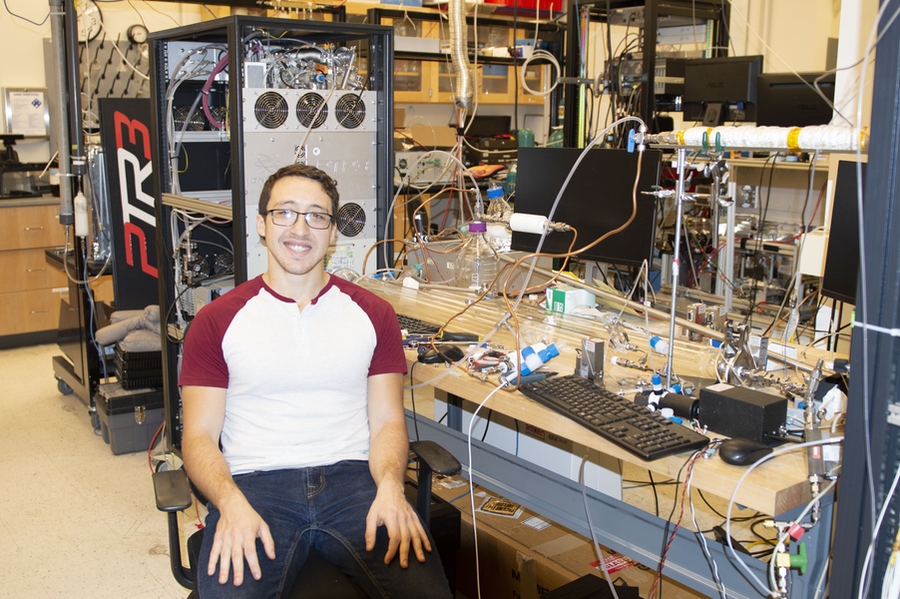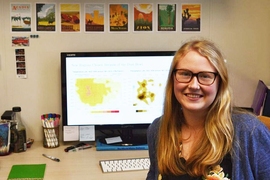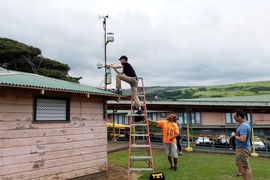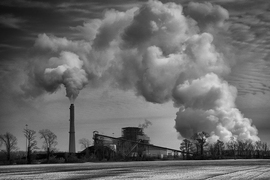Josh Moss is a PhD student in the lab of Professor Jesse Kroll, where he studies atmospheric chemistry and examines the chemistry of gases and particles in the atmosphere that humans are releasing and their interactions with existing particles in the atmosphere. He focuses on organic chemical reactions that occur in the atmosphere which contribute significantly to smog formation. In the laboratory, he uses a controlled atmospheric chamber to conduct physical experiments on the gas phase reactions that originate from smog particles. Moss also works on computer models for chemical reaction generation and predictions. His research is concerned with chemicals commonly found in large urban cities such as Los Angeles, Houston, and Mexico City, and he is interested in the implications that these micro-particles have on human health and climate change.
Q: What are the real-world implications of your research?
A: Primarily, much of what I study is related to urban pollution. My work is currently centered around understanding the impacts that gasoline, car emissions, and power-plant emissions have on smog formation, and what impacts they may have on the future of the environment. Due to the complexity of the atmosphere, it is difficult to break down all of the chemical reactions leading to smog formation, which is why this has become the focus of our research now.
I deal mostly with urban chemicals because they have generally been researched less than biologically emitted chemicals, and urban smog has adverse effects on human health in densely populated cities. In terms of human health, small smog particles are generally harmful for people to inhale because it can lead to various diseases such as heart failure, stroke, lung disease, and certain types of cancer. The largest source of uncertainty in global climate models is in these small particles. Right now, we are unsure exactly to what degree the particles are affecting the Earth’s temperature and climate. What we do know is that some particles can scatter sunlight, which cools the Earth. On the other hand, darker particles absorb sunlight and can actually warm the Earth. In addition to this, many particles lead to cloud formation, which contributes to both the cooling and warming of the Earth as well.
Humans are increasing the concentration of particles in the atmosphere on a regular basis. For instance, tiny particles can originate from burning or from particles that are formed from chemicals that have reacted in the atmosphere, known as secondary organic aerosol. Over the course of their reactions, they tend to stick together with other chemicals. Even though they are not emitted as particles, due to the chemical reactions that they undergo, particles are formed. Understanding secondary organic aerosol is really the core of my research. For example, if you look at a photo of LA, the smog formation over the city is extremely visible because they have an abundance of people in a concentrated area with countless cars. The combination of gas emissions together with the warm, sunny weather creates the perfect condition to form a great deal of smog particles. This is what I am really interested in when it comes to my research.
Q: What opportunities have you had to delve deeper into your research?
A: I was offered the opportunity to go to Paris last summer, which has led into the next exciting phase of my research, computer modeling. We are collaborating with a lab in Paris who has developed a unique software called GECKO-A that can predict chemical reactions in the atmosphere, giving me a new avenue to pursue in my research. Professor Kroll wrote a grant, funded by MIT International Science and Technology Initiatives with the lab in Paris, that enabled me to travel to France for almost a month in order to learn how to use the software. The software is very complex, relying on quantum chemistry knowledge to predict reactions. Jesse and I are excited for what this can tell us about the atmosphere that experiments cannot.
The atmosphere is arguably the most complex chemical system on Earth which makes it incredibly difficult to study. After several hours of reaction, a single chemical species can transform into millions of different chemicals. Even though we perform experiments in a controlled atmospheric chamber in our lab, it is impossible to measure and quantify every chemical that is generated during a reaction sequence. In order to dive further into my research, Jesse and I think the best course of action is to compare our experimental results to the model simulation results to improve both data sets. The models can give us detailed insight into the different chemical pathways related to smog formation, and the experimental data can serve to ground the model results in our observable reality.
Q: What is the next step for you?
A: I am still working to finish my thesis, however my long-term goals include becoming a professor. I love teaching and conducting research, so pursuing a career as a professor is a perfect fit for me. I have had several opportunities to TA classes here at MIT, including the Traveling Research Environmental Experience class (TREX), where I went to Hawaii with undergraduates to study volcanic emissions. TREX was one of the most fulfilling teaching experiences, and I hope to carry the excitement and joy I felt from TREX into all of my future teaching endeavors.
More recently, I have been mulling over a few other potential career paths. I am interested in environmental law and public policy because it would allow me to apply my research and knowledge in order to help shape the policies that protect our environment. I am very passionate about politics, and I have been concerned by the United States’ decreasing leadership role on the global stage, specifically in issues regarding climate change. I believe that scientists should take a more direct role in shaping critical policies, and I would be happy to contribute in any way that I can. My main passion lies in educating and informing people about the difficult and often highly nuanced environmental challenges that we face. I’ve given several public talks in the Boston area, and hosted a variety of classes for middle and high school students which I think is of vital importance for our collective future. I believe that the path to improving our environment, and more broadly our world, lies in education. If I can communicate my enthusiasm for environmental science and chemistry to others, I will consider it as a job well done.











